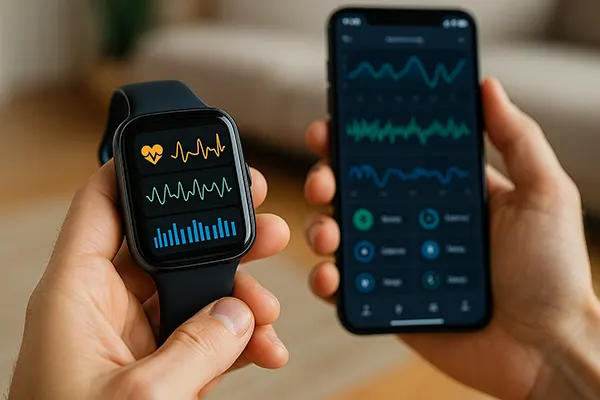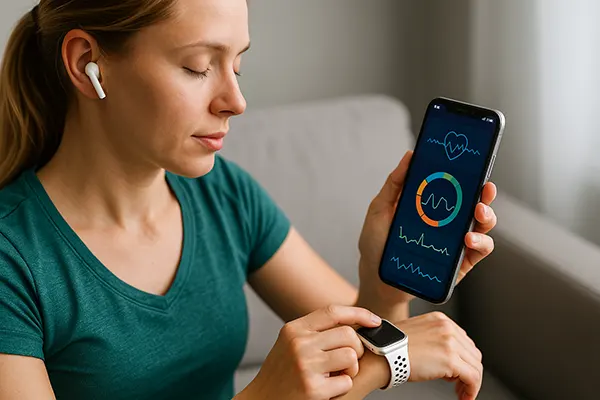Trends 2025: Digital Wellness Apps Powered by Biofeedback

Digital wellness tools in 2025 increasingly rely on biofeedback to help users understand how their bodies respond to daily activities, stress and recovery routines. Modern applications integrate sensors, validated metrics and real-time insights, offering a more grounded way to track personal wellbeing. These solutions are shaped by verified scientific methods, ensuring that the information users receive is accurate, measurable and aligned with current research.
How Biofeedback Shapes Everyday Wellness in 2025
Biofeedback has become a foundation of many popular wellness applications by providing data on heart rate variability, breathing patterns, muscle tension and sleep phases. Through sensor-equipped devices, users gain reliable metrics that reflect the state of their nervous system during rest and activity. This information helps individuals recognise patterns that previously remained unnoticed.
In 2025, integration with consumer wearables has reached a point where readings are far more precise than earlier generations. Optical sensors, electrical measurements and temperature tracking combine to build a complete overview of physiological reactions. As a result, wellness apps now concentrate on delivering practical interpretations instead of generic advice.
Many digital tools are designed with clinical research input, making their recommendations grounded in peer-reviewed studies. Developers collaborate with medical specialists, sleep researchers and sports scientists to ensure that the collected data is interpreted responsibly. This approach helps users receive actionable guidance without oversimplifying complex bodily processes.
Real-Time Insights and Personalised Adjustments
Applications offering real-time biofeedback updates allow individuals to adjust their breathing, correct posture or manage stress the moment irregularities occur. These features rely on stable algorithms that compare user data with validated physiological norms. The result is a more responsive wellness ecosystem that adapts to personal trends instead of relying on predefined settings.
Personalised adjustments within apps now consider several metrics simultaneously. For example, stress suggestions may analyse heart rate variability together with skin temperature and respiration depth. These combined readings create a multi-layered assessment that supports more accurate recommendations tailored to each user’s current condition.
Developers in 2025 prioritise transparency by clearly displaying how each metric contributes to suggested adjustments. Users can access explanations describing the mechanism behind each indicator and how it connects to overall wellbeing. This openness builds trust and encourages users to develop long-term habits based on reliable information.
Advances in Wearable Technology Supporting Biofeedback Apps
Wearable devices form the backbone of modern biofeedback solutions. The latest generation focuses on durability, battery efficiency and clinical-level sensors. Wrist devices, smart rings and flexible patches capture biometric data with far greater accuracy than models from earlier years. These improvements enable wellness apps to reflect users’ daily fluctuations with minimal deviation from laboratory-grade equipment.
In 2025, smart textiles have also become widely available. Clothing with embedded micro-sensors allows round-the-clock monitoring without the need for separate devices. Such garments measure heart rhythms, muscle activation and movement patterns naturally during daily routines, making the data more representative of real-life conditions.
The connection between wearables and apps has become more secure and stable. Encrypted data transmission and updated privacy protocols help ensure that biometric information remains confidential. Regulatory bodies require developers to follow strict data-handling standards, giving users a high level of protection and clarity regarding how their information is stored and used.
Integration with Professional Health Services
Many wellness apps now include features that allow voluntary sharing of metrics with health professionals. This option helps individuals receive informed feedback based on verified physiological readings. Doctors and therapists can interpret the data to support stress management, physical rehabilitation or lifestyle recommendations.
Some applications have begun offering built-in access to certified coaches or therapists. These specialists are trained to interpret biofeedback and provide guidance grounded in clinical practice. For users with particular health goals, this hybrid model—digital tracking paired with professional insight—offers a more balanced and realistic approach toward wellbeing.
Integration with health services is governed by strict confidentiality policies. Users must provide explicit consent for sharing any part of their data. These safeguards ensure that biometric information is managed responsibly and in accordance with health data regulations applicable in the UK and the EU.

AI-Enhanced Interpretation of Biofeedback Data
Artificial intelligence in wellness applications has evolved significantly by 2025. Instead of offering broad suggestions, AI models now interpret biofeedback data using large datasets verified by clinical research. These models help identify subtle patterns that may indicate fatigue, elevated stress or decreased recovery capacity, offering users timely insights.
Modern AI systems prioritise reliability by cross-checking metrics across several parameters. For example, if the algorithm detects irregular breathing patterns, it simultaneously evaluates heart rhythm, motion levels and temperature changes. This form of multi-metric verification helps reduce the risk of inaccurate recommendations and ensures that suggestions remain grounded in measurable indicators.
AI tools also give users clearer explanations of how they reached each insight. Applications now present transparent breakdowns, outlining which physiological signals contributed to each recommendation. This promotes informed decision-making and strengthens trust between users and digital wellbeing tools.
Future Directions for Biofeedback in Wellness Apps
Looking ahead, developers are focusing on expanding the precision and accessibility of biofeedback-based services. Miniaturised sensors integrated into everyday accessories are expected to improve the convenience of long-term tracking without compromising the quality of biometric data. This direction aligns with user demand for subtle, reliable devices.
Another promising area is the development of adaptive wellness programmes that update dynamically as the user’s condition changes. Instead of relying on fixed routines, future applications aim to adjust breathing sessions, movement recommendations or recovery steps in real time according to current biometric trends.
Furthermore, collaboration between research institutions, health organisations and developers will become even more important. By aligning consumer apps with scientifically validated methodologies, future digital wellness tools will continue to strengthen their role as trustworthy, practical instruments for everyday wellbeing.



